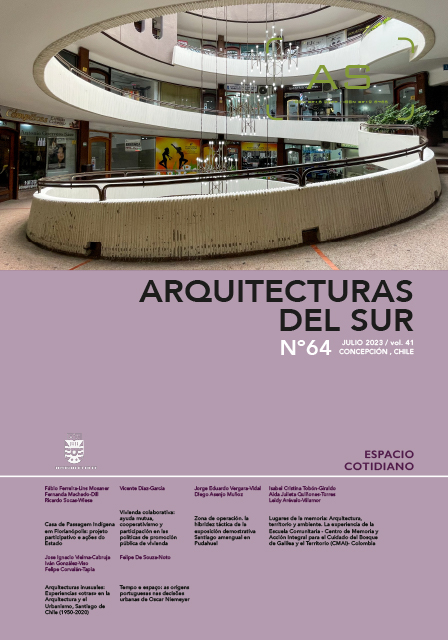Daily Space
DOI:
https://doi.org/10.22320/07196466.2023.41.064.00Keywords:
-Abstract
Three articles in this issue of Arquitecturas del Sur are dedicated to collective housing, as the housing shortage has led to new and better forms of citizen participation in its solution. The Indigenous Temporary Accommodation in Florianopolis handles an essentially Latin American problem: access for Indigenous people to protected state housing. In this case, the presence of the city’s original inhabitants examines the possibilities of physical and symbolic spaces in the contemporary city and the professional role that looks into the responses. Next, the text on collaborative housing analyzes the case of Spain, and its relationship with public management mechanisms. The case of Gran Canaria looks at mutual aid issues, transfer of use, cooperativism, and citizen participation. In this way, the self-construction system of the Andalusian Junta, a practice that is as effective as it is controversial, and representative of a socialist cooperativism and cohabitation developed by the Barcelona City Council, converge in the debate on cooperative management. The third text looks into one of the latest events disclosed on CORVI’s actions, before its dissolution in 1976. It explores a management model that revealed the role of construction companies as a new player in the habitational process for the case of the Santiago Amengual Neighborhood.
A second thematic group in this issue, materialized in its last 3 articles, returns to the structural issues of modern-day architecture, whose presence is diving deeper into the disciplinary debate. The places of memory seem to exceed the margins of an understanding based on heritage discourse. The memory and belonging of daily spaces, turn one to the nodes of memory and collective coherence. This is the case of the Community School – Center of Memory and Integrated Action to Care for the Forest of Galilea and the Territory of Colombia. Likewise, the individual, isolated, and selective expressions examine those unusual experiences where otherness exercises protagonism over experiences in the architecture and city of Santiago de Chile. Finally, revisiting the works of a master like Niemeyer opens the possibility for rereading, through actions based on the Portuguese decisions in two of his works: the urban complex of Pena Furada, in Portugal (1965), and Plaza XV, in Rio de Janeiro (1991).
Downloads
References
-
Downloads
Published
How to Cite
Issue
Section
License
Copyright (c) 2023 Pablo Ramón Fuentes-Hernández, Gonzalo Andrés Cerda-Brintrup

This work is licensed under a Creative Commons Attribution-ShareAlike 4.0 International License.
The content of the articles published in each issue of Arquitecturas del Sur is the sole responsibility of the authors and does not necessarily represent the opinion of University of the Bío-Bío.
The authors will maintain their copyright; however, they will guarantee the journal the right to first publication and dissemination of their work. The publication of the article in Arquitecturas del Sur will be subject to the Creative Commons International license (CC BY-SA) that allows others to adapt: remix, transform and build on the material for any purpose, even commercially; share: copy and redistribute the material in any medium or format, as long as the authorship and first publication in this journal are acknowledged by citing them correctly, and their new contributions are under a license with the same terms.














 Programa de Información Científica/Concurso Fondos de Publicación de Revistas Científicas 2018/ Proyecto Mejoramiento de Visibilidad de Revistas UBB (Código:FP180007)
Programa de Información Científica/Concurso Fondos de Publicación de Revistas Científicas 2018/ Proyecto Mejoramiento de Visibilidad de Revistas UBB (Código:FP180007) 
